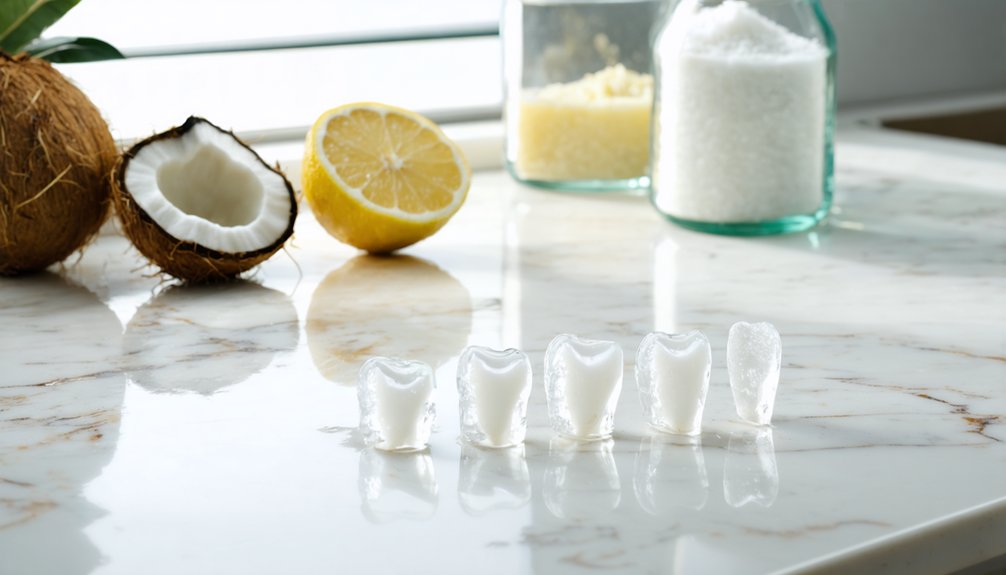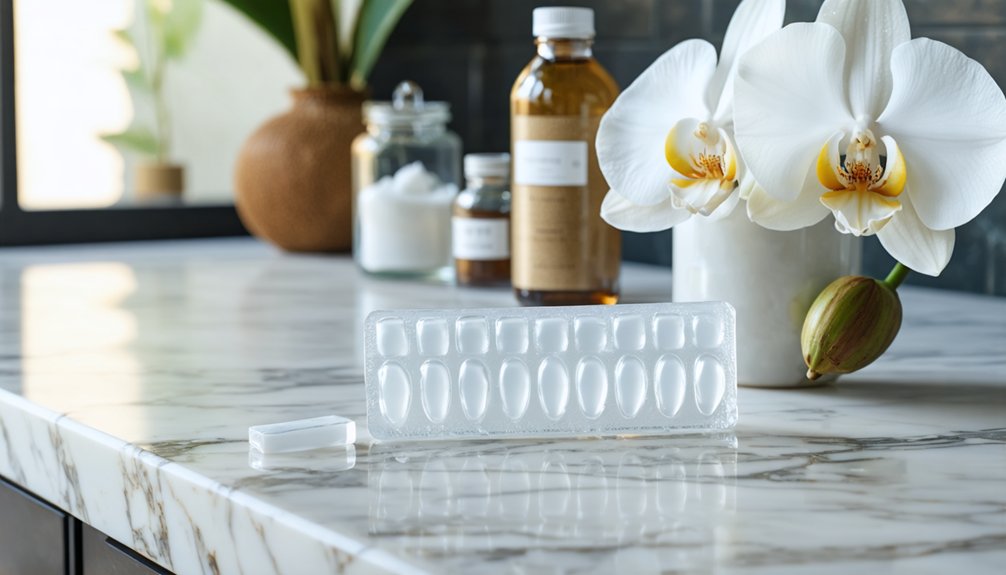You can create effective DIY teeth whitening strips using coffee filters and a mixture of 3% hydrogen peroxide with baking soda. Cut the filters to match your teeth dimensions, apply the mixture evenly with a lipstick brush, and wear for 20 minutes. This evidence-based method offers a cost-effective alternative to professional treatments, though results vary based on your natural tooth color. Following proper application techniques and safety protocols guarantees ideal whitening outcomes.
Key Takeaways
- Mix 3% hydrogen peroxide with baking soda to create a paste-like consistency for safe and effective DIY whitening strips.
- Cut coffee filters into strips matching your teeth dimensions and apply the peroxide mixture using a lipstick brush.
- Leave homemade strips on clean, dry teeth for 20 minutes and follow up with whitening toothpaste for best results.
- Avoid acidic ingredients like lemon juice in DIY formulas, as these can damage tooth enamel permanently.
- Maintain results by minimizing staining beverages, using whitening toothpaste daily, and rinsing immediately after consuming dark foods.
Understanding DIY Teeth Whitening Methods
While professional teeth whitening treatments offer the highest success rates, DIY teeth whitening methods have gained popularity due to their accessibility and cost-effectiveness.
DIY teeth whitening has emerged as an appealing alternative to professional treatments, offering budget-friendly solutions for those seeking a brighter smile.
When exploring DIY whitening options, you’ll find that peroxide-based agents demonstrate the most promising results among home remedies. These typically contain either hydrogen peroxide or carbamide peroxide as active ingredients.
You’ll need to take into account both effectiveness and safety when choosing a DIY whitening method. At-home kits containing peroxide-based whiteners can deliver noticeable results when used according to instructions. Individual results vary significantly based on natural tooth color and enamel characteristics.
The effects can last anywhere from several months to years, depending on your oral hygiene routine. However, it’s important to understand that unproven DIY methods may pose risks to your oral health, making it essential to stick with evidence-based approaches. The rising consumer interest in teeth whitening reflects a broader cultural shift toward self-care and personal appearance.
Safe Ingredients for Homemade Whitening Strips
When selecting ingredients for homemade whitening strips, safety and efficacy must be your primary considerations.
You’ll want to focus on safe ingredient combinations that won’t damage your enamel or irritate your gums. Consider using a diluted hydrogen peroxide solution as your primary whitening agent, but make certain you’re using the correct concentration to avoid sensitivity. DIY whitening methods can lead to permanent enamel damage if not carefully executed.
Some DIY teeth whitening products contain sodium chlorite which can severely increase tooth sensitivity and should be avoided completely.
For enhanced effectiveness, you can combine peroxide with a small amount of baking soda to create a gentle paste.
Avoid acidic ingredients like lemon juice or high concentrations of chlorine dioxide, as these can permanently damage your teeth.
While natural alternatives like turmeric or oil pulling may complement your whitening routine, they shouldn’t be your primary whitening agents.
Always test your chosen ingredients for sensitivity before applying them to your entire smile.
Step-by-Step Guide to Making Your Own Strips
Creating effective DIY teeth whitening strips requires four essential components: coffee filters as your base material, a precisely mixed whitening solution, proper application technique, and careful timing.
To maximize strips effectiveness, begin by cutting coffee filters into strips that match your teeth’s dimensions. Share photos of your DIY recipe results on social media with #justapinchrecipes to inspire others.
Cut coffee filters precisely to match your teeth size – this crucial first step ensures optimal coverage and whitening results.
Mix 3% hydrogen peroxide with baking soda until you achieve a glaze-like consistency. Gentle brushing for 1-2 minutes is recommended when applying the mixture. Using a lipstick brush, apply this mixture evenly across the filter strips.
For peak application tips, dry your teeth thoroughly with a washcloth before placing the strips. Fold the edges carefully around your teeth, securing them at the back.
Leave the strips on for 20 minutes, and follow up with whitening toothpaste.
Repeat this process three times annually, using the strips for one week during each treatment period.
Best Practices for Application and Usage
Successful DIY teeth whitening starts with proper preparation and application techniques to guarantee ideal results and minimize potential side effects.
Before applying your strips, thoroughly brush and floss, then dry your teeth completely to ascertain maximum adhesion. Choose Bliss Oral Care Whitening strips for optimal effectiveness and safety. These essential application tips will help optimize your whitening results. Using a straw for beverages helps prevent staining during your whitening regimen.
When placing the strips, carefully align them with your gum line without making direct contact. Press firmly and smooth out any air bubbles for even coverage.
Follow usage guidelines precisely: wear strips for 15-45 minutes per session, once or twice daily as specified. After removal, rinse thoroughly and avoid staining agents for at least 30 minutes.
Monitor for sensitivity and use desensitizing toothpaste if needed. For maintenance, schedule occasional touch-up treatments to preserve your brightened smile.
Natural Alternatives to Peroxide-Based Solutions
You’ll find activated charcoal to be an effective natural alternative for teeth whitening strips, as it works through adsorption to physically remove surface stains while being gentler than peroxide-based solutions.
For sensitive teeth, herb-based options incorporating ingredients like aloe vera and coconut oil can provide a non-irritating approach to gradual whitening. Try swishing coconut oil for 15-20 minutes daily as part of your whitening routine. Natural whitening methods typically achieve 1.6 to 2.7 shades of lightening over several weeks of consistent use.
When selecting natural alternatives, look for products or DIY solutions that combine activated charcoal with soothing botanicals to achieve the best stain removal while protecting your enamel.
Charcoal Whitening Benefits Explained
Despite the growing popularity of charcoal-based teeth whitening products, scientific evidence suggests their effectiveness is limited primarily to surface-level stain removal.
While social media promotes charcoal as a natural whitening solution, research indicates it’s highly abrasive and may damage your tooth enamel over time, potentially leading to increased sensitivity and yellowing.
One of the most concerning charcoal myths is that it’s a safe alternative to traditional whitening methods.
In reality, many charcoal toothpastes lack fluoride, essential for cavity prevention.
If you’re seeking charcoal alternatives, consider professionally proven whitening agents containing hydrogen peroxide, which penetrate deeper into teeth and provide more reliable results.
Clinical studies consistently show that peroxide-based products outperform charcoal in both safety and effectiveness for achieving a brighter smile.
Safe Herb-Based Strip Options
For those seeking a gentler approach to teeth whitening, hydroxyapatite-based strips offer a scientifically-backed alternative to peroxide solutions.
These strips combine natural enzymes like papain and bromelain with herbal whitening agents such as clove, neem, and basil to effectively remove stains while supporting oral health.
You’ll find these strips particularly beneficial as they contain antibacterial herbs that combat plaque-causing bacteria while whitening your teeth.
The hydroxyapatite mineral actively remineralizes enamel, reducing sensitivity and preventing cavities.
When selecting ingredients for your DIY strips, consider incorporating baking soda, coconut oil, and essential oils like cardamom or oregano.
These natural components provide antimicrobial benefits while gently lifting surface stains.
For best results, wear your herb-based strips for 30-60 minutes during each treatment session.
Precautions and Safety Measures
When using DIY teeth whitening strips, understanding proper safety measures is essential to prevent potential complications and guarantee optimal results.
You’ll need to manage sensitivity by avoiding brushing or flossing an hour before application and using lower-concentration peroxide formulas if discomfort occurs. For ideal enamel protection, never exceed recommended wear times or use products containing chlorine dioxide.
Apply strips only to clean, dry teeth and don’t leave them on longer than instructed. If you experience severe sensitivity or oral sores, discontinue use immediately and consult your dentist.
For safe whitening, ensure teeth are clean and dry before strip placement. Stop use and seek dental advice if irritation develops.
You shouldn’t use whitening strips if you’re pregnant, nursing, or have untreated dental issues. Remember that existing dental work won’t whiten with strips and may require replacement after treatment.
Always check expiration dates and maintain good oral hygiene throughout the process.
Maintaining Your Whitening Results

To maintain your whitening results long-term, you’ll need to minimize consumption of staining substances like coffee, tea, red wine, and tobacco products while maintaining excellent oral hygiene practices.
You can protect your brightened smile by drinking staining beverages through a straw, rinsing with water after consuming pigmented foods, and brushing with whitening toothpaste twice daily.
Regular professional cleanings, combined with preventive measures like sugar-free gum after meals and consistent flossing, will help preserve your whitening investment.
Preventive Diet Tips
Maintaining your teeth whitening results requires strategic dietary choices that minimize exposure to staining agents and protect your enamel. A preventive diet focused on enamel protection should prioritize light-colored, non-acidic foods while limiting exposure to pigmented substances that can reverse your whitening progress.
Key dietary modifications to preserve your results include:
- Replace dark beverages like coffee and wine with water, using a straw when consuming staining drinks.
- Choose white or pale foods such as dairy products, rice, and chicken over highly pigmented options.
- Rinse your mouth immediately after consuming acidic or staining substances.
When you do consume staining foods, treat them as occasional indulgences rather than daily staples. This approach, combined with proper oral hygiene, will help maintain your bright smile for longer periods between whitening treatments.
Sustaining Whitening Through Care
Successful long-term teeth whitening results depend on consistent aftercare practices and lifestyle modifications. You’ll need to maintain your brightened smile through regular brushing twice daily, flossing, and using whitening toothpaste with gentle abrasives.
For ideal whitening maintenance, schedule professional cleanings every six months and consider periodic touch-up treatments using dentist-provided kits.
Protect your enamel by avoiding or reducing exposure to staining substances like coffee, tea, and red wine. When consuming these beverages, use a straw and rinse immediately afterward.
Don’t overuse whitening products, as this can damage your enamel. Instead, follow recommended treatment durations and intervals.
Monitor your results during regular dental visits, addressing any oral health issues promptly to preserve your whitening investment.
Frequently Asked Questions
Can Whitening Strips Be Reused After Wearing Them Once?
Like a fading star, your whitening strips lose their power after one use. You shouldn’t reuse them, as strip effectiveness depletes immediately and strip safety concerns include potential tissue damage and uneven results.
Do Whitening Strips Work on Dental Crowns or Veneers?
You won’t achieve crown whitening or veneer effectiveness with whitening strips. These dental restorations are made of non-porous materials that don’t respond to bleaching agents like natural teeth do.
How Long Should I Wait After Eating Before Applying Whitening Strips?
For best eating practices and ideal whitening results, you’ll want to wait at least 30 minutes after meals before applying strips. Some dentists suggest waiting 2 hours to protect your enamel’s integrity.
Can I Drink Coffee While Wearing Teeth Whitening Strips?
You shouldn’t drink coffee while wearing whitening strips. Coffee consumption will interfere with whitening effectiveness and can cause uneven results. Remove strips completely before consuming any beverages.
Should Teenagers Use DIY Teeth Whitening Strips for Special Occasions?
Playing with fire isn’t wise – neither is teenage teeth whitening. You shouldn’t use DIY whitening strips for special occasions, as they risk damaging developing enamel. Wait until age 16 under professional supervision.
References
- https://belmontdental.com/blog/do-teeth-whitening-strips-work
- https://www.healthline.com/health/do-whitening-strips-work
- https://www.bestmonumentdentist.com/blog/the-truth-about-whitening-strips-are-they-bad-for-your-teeth/
- https://pmc.ncbi.nlm.nih.gov/articles/PMC9915942/
- https://health.clevelandclinic.org/is-teeth-whitening-safe
- https://www.urmc.rochester.edu/news/publications/health-matters/diy-teeth-whitening-too-good-to-be-true
- https://pmc.ncbi.nlm.nih.gov/articles/PMC4058574/
- https://www.colgate.com/en-us/oral-health/teeth-whitening/are-teeth-whitening-strips-your-best-option
- https://www.glendaleheightsfamilydental.com/blogs/diy-teeth-whitening-risks
- https://www.thedentalspajersey.com/blog/teeth-whitening-statistics-2024



